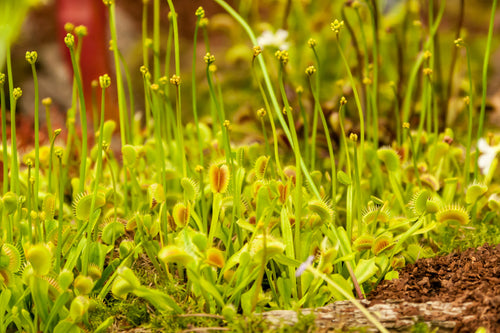The Venus Fly Trap is the most well recognized and cultivated carnivorous plants. It is part of a monotypic genus called Dionaea. There is only one species of Venus flytrap named Muscipula. There are however hundreds of cultivars (variations) that have been created by selective breeding. Examples of cultivars include Alien, Maroon Monster, B52, Jaws and Green Dragon.


The Venus flytrap is a perennial herb. It is a small plant whose structure can be described as a rosette of four to seven leaves which arise from a short subterranean (underground) rhizome (stem). Each stem reaches a maximum size of about three to ten centimeters depending on the time of year. Longer leaves with robust traps are usually formed after flowering. Flytraps develop flowers in the spring and insects assist in pollinating the seeds in the wild. They can also be propagated by leaf pulling or tissue culture in a laboratory. Plants take around four to five years to reach maturity when grown from seed and with the correct care can live almost indefinitely. They do not grow tall but they spread out in diameter and can have more than twenty large traps. Venus flytraps are native to North America. The only place that they grow wild in the wild is on the eastern coast of North and South Carolina along a 145 km range. They have been collected nearly to extinction and are now considered endangered in North Carolina. They grow in subtropical wetlands, swamps, bogs, marshes and low-lying flatlands where the soil is boggy and nutrient deficient. They like hot, humid conditions with lots of sun.
Venus flytraps are native to North America. The only place that they grow wild in the wild is on the eastern coast of North and South Carolina along a 145 km range. They have been collected nearly to extinction and are now considered endangered in North Carolina. They grow in subtropical wetlands, swamps, bogs, marshes and low-lying flatlands where the soil is boggy and nutrient deficient. They like hot, humid conditions with lots of sun.


Flytraps catch prey to supplement their diets. There varied prey include flies, crickets, arachnids and even an occasional frog. The Venus flytrap has a very high protein to nitrogen conversion rate resulting in fast growth after eating a meal. The leaves of the Venus flytrap have evolved into active spring traps that use a combination of bright pigment, sweet smells and sugary nectar to attract their prey. Each trap has six trigger hairs, three on each lobe. After an insect has stimulated at least one trigger hair at least twice, the trap will close quickly. An insect caught inside the partially closed trap will thrash about in an attempt to escape.This serves as the signal for the trap to close completely. The speed with which the trap closes varies depending on the amount of humidity, light, size of prey and general growing conditions and can also serve as an indicator of a plant’s overall health. Glands located in the leaves release enzymes that start digesting the prey and the nutrients are then absorbed by the leaves leaving behind a dry, powdery husk. Flytraps use a lot of energy when capturing their prey and traps should never be triggered just for fun as it can cause the overall health of the plant to decline. Each trap can catch between four to six insects and after that the trap turns brown and dies back. It can take up to ten days for a Venus flytrap to completely digest a large meal and reopen its trap.